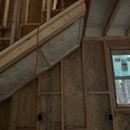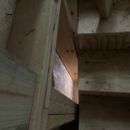Sealing within stud bays along stairs
Hi All-
We have been making progress on our garage with ADU (described previously://m.etiketa4.com/question/ensuring-good-air-quality-in-garage-apartment)
We have been sealing everything between the garage and apartment, including electrical and plumbing penetrations. We had the underside of the stairs spray foamed, and now realize we hadn’t thought about how to seal the stud bays that run along the side of the stairs (see pictures). There will be drywall under the stairs meeting the wall drywall. However, everywhere else we’ve put in an extra layer of sealing (sealant + xps, or close cell spray foam) in addition to drywall, so that we’re not relying on drywall with paint as the only air barrier.
Any advise on how to seal within the stud bays? As described in my other post, we have 3” of xps on the exterior, which may affect the approach.
thanks!
GBA Detail Library
A collection of one thousand construction details organized by climate and house part












Replies
这可能是她更容易密封外端athing here if you haven't already put that up, but it looks like that part is probably done. Exterior sheathing tends to be easier around complex areas because you're only sealing a single plane, a sheet of plywood basically, which is much simpler than sealing around a bunch of intersecting pieces with goofy angles.
Your best bet around your stairs is probably a combination of caulk and 'injected' canned foam. What I've done in the past with gaps that are a little too big for caulk, but a little too small for canned foam, is to use the plastic tips for the canned foam gun as a sort of injection needle. I stick the tip into the gap, and inject foam as I move along the gap. The result is that the foam expands into the gap, sealing it, and oozes out around the edges. I've even filled ant galleries this way with some success. You'll just have to take care not to miss anything as you go, since you have lots of little gaps in that pic that you need to pay attention to.
Note that you don't necassarily need to seal EVERY gap. You only need to seal gaps that provide an air path between conditioned and unconitioned spaces. There is no need to seal gaps that have conditioned space on BOTH sides unless you're trying to limit sound transmission.
Bill
Thanks for the suggestions. Our complication is that we are trying to seal the garage from the upstairs apartment. So, our sheathing to the outside is very well sealed, and now we are trying to be sure we don’t get garage fumes (I should have put that more clearly in my post!).
Everything is well sealed within the joist bays and in the rim joists, except in the 2x6 stud bays along the stairs. In that location, it’s totally open between floors (see second picture). I’m trying to imagine if plywood blocking in each stud bay with sealant is the best way to go? Or….???? Something else?
I would try using 1/2" foil faced polyiso with seams taped and the perimeted sealed to the framing on all dividing walls/stairs/ceilings between the living and garage spaces. I like to use foil tape (Nashua 324A, etc.) for the seams since it sticks well and matches the foil facer. This gives you a nice, impermeable, air and vapor barrier. I would drywall over that with 5/8" type X drywall (typically required in garages attached to living spaces for fire protection).
Using polyiso, you can "box over" things like the stairs and seal all the seams with tape. In this way, you can more easily ensure a good air barrier so your drywall details aren't as critical. The polyiso also gets you a bit of continuous insulation, adding R value to your assembly.
Bill